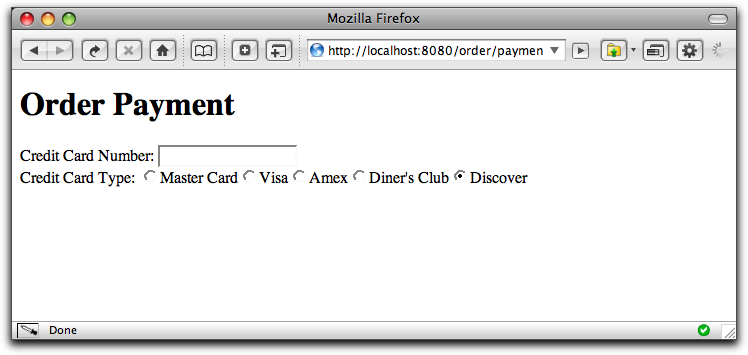 org.apache.tapestry5.corelib.components.Radio
org.apache.tapestry5.corelib.components.Radio
|
||||||||||
| PREV CLASS NEXT CLASS | FRAMES NO FRAMES | |||||||||
| SUMMARY: NESTED | FIELD | CONSTR | METHOD | DETAIL: FIELD | CONSTR | METHOD | |||||||||
java.lang.Objectorg.apache.tapestry5.corelib.components.Radio
public class Radio
A radio button (i.e., <input type="radio">). Radio buttons must operate within a
RadioContainer (normally, the RadioGroup component).
RadioGroup,
Form,
Select| Component Parameters | ||||||
|---|---|---|---|---|---|---|
| Name | Description | Type | Flags | Default | Default Prefix | Since |
| disabled | If true, then the field will render out with a disabled attribute (to turn off client-side behavior). Further, a disabled field ignores any value in the request when the form is submitted. | boolean | false | prop | ||
| label | The user presentable label for the field. If not provided, a reasonable label is generated from the component's id, first by looking for a message key named "id-label" (substituting the component's actual id), then by converting the actual id to a presentable string (for example, "userId" to "User Id"). | String | literal | |||
| value | The value associated with this radio button. This is used to determine which radio button will be selected when the page is rendered, and also becomes the value assigned when the form is submitted. | Object | Required | prop | ||
Radio components are always used in conjunction with a RadioGroup component. The RadioGroup defines the property that will be read and updated, and the individual Radio components determine what value will be assigned to the property.
Our example will be part of a page that collects credit card information. We'll just be showing the portions related to a set of radio buttons for choosing the type of credit card.

public enum CardType
{
MASTER_CARD, VISA, AMERICAN_EXPRESS, DINERS_CLUB, DISCOVER
}
<html xmlns:t="http://tapestry.apache.org/schema/tapestry_5_0_0.xsd">
<body>
<h1>Order Payment</h1>
<t:form>
<t:label for="cardNumber"/>:
<t:textfield t:id="cardNumber" size="16"/>
<br/>
<t:label for="type"/>:
<t:radiogroup t:id="type">
<t:radio t:id="masterCard"/>
<t:label for="masterCard"/>
<t:radio t:id="visa"/>
<t:label for="visa"/>
<t:radio t:id="amex"/>
<t:label for="amex"/>
<t:radio t:id="dinersClub"/>
<t:label for="dinersClub"/>
<t:radio t:id="discover"/>
<t:label for="discover"/>
</t:radiogroup>
</t:form>
</body>
</html>
The advantage of using radio buttons here, rather than a drop down list, is that we could extend the labels to use a small image of each type of supported card.
We're once again using the trick of matching the component's id to a property of the containing page. The RadioGroup's value parameter will be bound to the page's type property. Likewise, each of the Radio components will be matched to a property of the page.
public class Payment
{
. . .
@Property
@Persist
private CardType type;
public CardType getMasterCard() { return CardType.MASTER_CARD; }
public CardType getVisa() { return CardType.VISA; }
public CardType getAmex() { return CardType.AMERICAN_EXPRESS; }
public CardType getDinersClub() { return CardType.DINERS_CLUB; }
public CardType getDiscover() { return CardType.DISCOVER; }
. . .
}
We use a number of read-only properties to provide each Radio component with its corresponding enum value, that will ultimately be assigned to the page's type property (if that corresponding Radio component is selected by the user).
This is far from the only pattern of usage; it is much more likely that you will use a Loop component around a single Radio component than you will use a whole array of Radio components as in this example.
We override the default generated labels for a few fields and enum values:
cardnumber-label=Credit Card Number type-label=Credit Card Type dinersclub-label=Diner's Club
| Constructor Summary | |
|---|---|
Radio()
|
|
| Method Summary | |
|---|---|
String |
getClientId()
Returns a unique id for the element. |
String |
getControlName()
Returns the control name provided by the containing RadioContainer. |
String |
getLabel()
Returns a user presentable (localized) label for the field, which may be used inside <label> elements on the client, and inside client or server-side validation error messages. |
boolean |
isDisabled()
Returns true if this component has been expressly disabled (via its disabled parameter), or if the container has been disabled. |
boolean |
isRequired()
Returns false; the RadioComponent component does not support declarative field validation. |
| Methods inherited from class java.lang.Object |
|---|
clone, equals, finalize, getClass, hashCode, notify, notifyAll, toString, wait, wait, wait |
| Constructor Detail |
|---|
public Radio()
| Method Detail |
|---|
public String getControlName()
RadioContainer.
getControlName in interface FieldFormSupport.allocateControlName(String)public String getLabel()
Field
getLabel in interface FieldLabelpublic boolean isDisabled()
container has been disabled.
isDisabled in interface Fieldpublic String getClientId()
ClientElement
getClientId in interface ClientElementpublic boolean isRequired()
isRequired in interface Field
|
||||||||||
| PREV CLASS NEXT CLASS | FRAMES NO FRAMES | |||||||||
| SUMMARY: NESTED | FIELD | CONSTR | METHOD | DETAIL: FIELD | CONSTR | METHOD | |||||||||